RNA Interference and Functional Genomics in Fungi
- 格式:pdf
- 大小:529.10 KB
- 文档页数:20
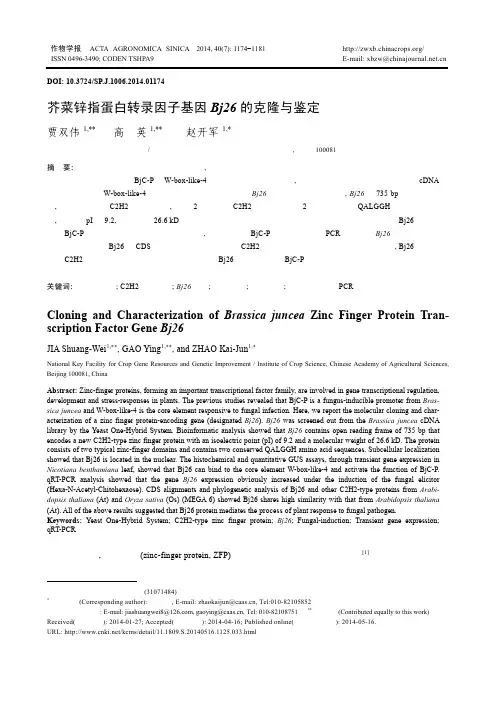
作物学报ACTA AGRONOMICA SINICA 2014, 40(7): 1174−1181/ISSN 0496-3490; CODEN TSHPA9E-mail: xbzw@ DOI: 10.3724/SP.J.1006.2014.01174芥菜锌指蛋白转录因子基因Bj26的克隆与鉴定贾双伟1,∗∗高英1,∗∗赵开军1,∗中国农业科学院作物科学研究所 / 农作物基因资源与基因改良国家重大科学工程, 北京 100081摘要: 锌指蛋白是一类重要的转录因子家族, 参与植物基因转录调节、发育及胁迫反应等生理过程。
我们前期研究发现芥菜诱导型启动子BjC-P的W-box-like-4为其真菌诱导的核心元件, 本研究通过酵母单杂交技术从芥菜cDNA文库中筛选到与W-box-like-4序列特异互作的转录因子基因Bj26。
生物信息学分析表明, Bj26含735 bp的开放阅读框, 编码一个新的C2H2型锌指蛋白, 包括2个典型的C2H2型锌指结构及2个植物特有的QALGGH氨基酸保守序列, 等电点pI为9.2, 分子量为26.6 kD。
亚细胞定位显示该蛋白位于细胞核。
本氏烟瞬时表达分析表明Bj26蛋白通过与BjC-P的真菌诱导核心元件序列特异互作, 激活启动子BjC-P。
实时荧光定量PCR结果显示Bj26在真菌诱导下表达量明显增高。
Bj26的CDS序列与拟南芥和水稻中的C2H2型锌指蛋白序列比对及进化树分析表明, Bj26与拟南芥的C2H2型蛋白同源性高于水稻。
以上结果揭示Bj26蛋白可能介导BjC-P真菌诱导响应并参与植物抗真菌病原菌的调控过程。
关键词:酵母单杂交; C2H2锌指蛋白; Bj26基因; 真菌诱导; 瞬时表达; 实时荧光定量PCRCloning and Characterization of Brassica juncea Zinc Finger Protein Tran-scription Factor Gene Bj26JIA Shuang-Wei1,∗∗, GAO Ying1,∗∗, and ZHAO Kai-Jun1,∗National Key Facility for Crop Gene Resources and Genetic Improvement / Institute of Crop Science, Chinese Academy of Agricultural Sciences, Beijing 100081, ChinaAbstract: Zinc-finger proteins, forming an important transcriptional factor family, are involved in gene transcriptional regulation, development and stress-responses in plants. The previous studies revealed that BjC-P is a fungus-inducible promoter from Bras-sica juncea and W-box-like-4 is the core element responsive to fungal infection. Here, we report the molecular cloning and char-acterization of a zinc finger protein-encoding gene (designated Bj26). Bj26 was screened out from the Brassica juncea cDNA library by the Yeast One-Hybrid System. Bioinformatic analysis showed that Bj26 contains open reading frame of 735 bp that encodes a new C2H2-type zinc finger protein with an isoelectric point (pI) of 9.2 and a molecular weight of 26.6 kD. The protein consists of two typical zinc-finger domains and contains two conserved QALGGH amino acid sequences. Subcellular localization showed that Bj26 is located in the nuclear. The histochemical and quantitative GUS assays, through transient gene expression in Nicotiana benthamiana leaf, showed that Bj26 can bind to the core element W-box-like-4 and activate the function of BjC-P. qRT-PCR analysis showed that the gene Bj26 expression obviously increased under the induction of the fungal elicitor (Hexa-N-Acetyl-Chitohexaose). CDS alignments and phylogenetic analysis of Bj26 and other C2H2-type proteins from Arabi-dopsis thaliana (At) and Oryza sativa (Os) (MEGA 6) showed Bj26 shares high similarity with that from Arabidopsis thaliana (At). All of the above results suggested that Bj26 protein mediates the process of plant response to fungal pathogen.Keywords: Yeast One-Hybrid System; C2H2-type zinc finger protein; Bj26; Fungal-induction; Transient gene expression; qRT-PCR在植物中, 锌指蛋白(zinc-finger protein, ZFP)形成一类较大的转录因子家族[1]。

东南大学博士学位论文基因密码子使用和蛋白质结构的生物信息学分析姓名:***申请学位级别:博士专业:生物医学工程指导教师:***20040401东南大学博士学位论文摘要论文题目:基因密码子使,qJ和蛋白质结构的生物信息学分析研究生姓名:顾万君导师姓名:陆祖宏(教授)学校名称:东南人学随着人类基冈组计划雨I模式生物基因组计划的完成,公共数据库中生物数据的增艮速度越来越快。
如何从海量的生物数据中解读、提取和获得有片;|的生物信息,己成为基因组计划下一步亟待解决的问题。
本文中,我们利用生物信息学的方法对基因的周义密码子使用进行了统计分析,研究了不局物种中蛋白质结构和基因周义密码子使用间可能存在的相关性,提出了一种基于密码子的氨基酸二级结构偏向性参数。
同时,我们还在蛋白质二级结构预测的神经网络方法中引入了蛋白质编码基因的密码子使用信息.在预测大肠杆菌的蛋白质的二级结构时提高了预测的准确率。
最后,我们还提出了一种根据单倍体数据将基冈组划分成若干很少出现重组现象的块结构的新方法。
论文的主要内容如下:1.在基因组中,基因的同义密码子使用并不是随机选择的。
研究不周物种中基因的密码子使用模式以及形成这种密码子使用模式的内在因素,对于了解基因组的特征和物种的分子进化具有重要作崩。
我们对一些物种的基因密码子使用模式进行了分析,并且进一步分析了这些物种中影响密码子使用的内在因素。
●通过SARS病毒基因组和进化上相近的病毒基因组的密码子使用偏性的分析,我们发现在这些病毒基冈组中尽管基因的同义密码子使用存在着偏向性,但是偏向性程度并不高。
这些病毒基因组中,影响同义密码子使用的最主要因素是进化中的碱基突变压力。
同时,基冈的功能也在一定程度上决定了这些病毒基因中密码子的选择。
但是,基因长度和基因翻译过程中的选择作用在这些病毒中并不影响基因的密码子使用。
另外,在这些病毒基囡组中,密码子使用模式在进化上是保守的。
基于密码子使用模式的进化分析表明,SARS冠状病毒在进化上与其它己知的冠状病毒都不是很近。
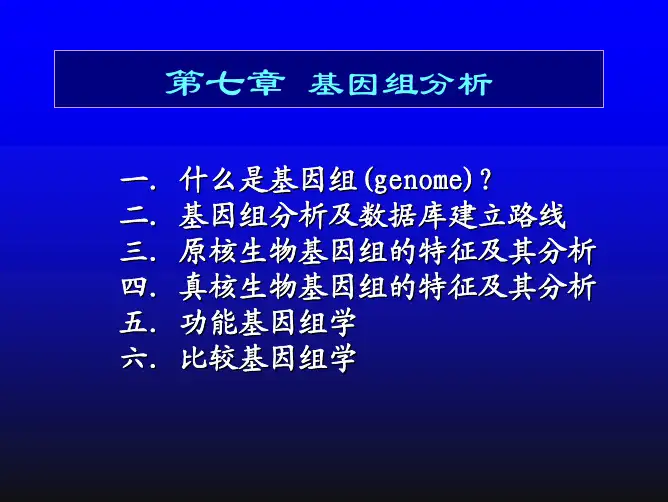

甘蔗梢腐病菌FusariumsacchariCYP51基因克隆及遗传转化作者:周宇明黄振段真珍李慧雪暴怡雪张木清姚伟来源:《热带作物学报》2021年第12期摘要:甾醇14α-去甲基化酶(CYP51)是生物細胞膜合成所需的一个非常重要的酶,在病原菌的耐药性、致病性和生长繁殖等方面发挥着非常重要的作用。
研究表明干扰真菌的CYP51基因表达导致其无法正常生长,显著降低其致病性。
本研究以甘蔗梢腐病菌甘蔗镰刀菌(Fusarium sacchari)为试验材料,根据基因组测序数据设计特异性引物克隆得到了FsCYP51基因全长和CDS全长。
生物信息学分析表明,该基因序列全长1947 bp,编码区由2个内含子和3个外显子组成,CDS全长1554 bp,编码517个氨基酸,编码蛋白理论相对分子量为58.61 kDa。
其编码蛋白的二级结构主要由α-螺旋和无规卷曲构成,具有典型的CYP51保守结构域。
预测其亚细胞定位于细胞膜,且存在2个跨膜区域。
系统进化分析表明,FsCYP51基因属于CYP51C这一类,与串珠镰刀菌(F. verticillioides)的CYP51C基因亲缘关系最近。
同时,根据克隆到的基因全长和CDS全长构建了多价HIGS植物表达载体,并利用基因枪介导的遗传转化方法将干扰片段成功转化至甘蔗受体材料,为研究FsCYP51基因功能和创制抗梢腐病甘蔗种质奠定基础。
关键词:甘蔗镰刀菌;CYP51;基因克隆;HIGS;遗传转化中图分类号:S432.1 文献标识码:AAbstract: CYP51 is a very important enzyme for the biosynthesis of biological cell membrane, and plays a very impor-tant role in drug resistance, pathogenicity, growth and reproduction of pathogens. The interference with expression of CYP51 gene in fungi can prevent its normal growth and significantly reduce its pathogenicity. In this study, the full length of FsCYP51 gene and CDS were cloned by designing specific primers based on the genome sequencing data of Fusarium sacchari. Bioinformatics analysis showed that the total length of the gene was 1947 bp,and the coding region consisted of two introns and three exons. The total length of CDS was 1554 bp, encoding 517 amino acids. The theoretical relative molecular weight of the coding protein was 58.61 kDa. The secondary structure of the encoded protein was mainly co mposed of α-helix and random coils, and it had a typical conserved domain CYP51. Its subcellular localization was predicted in the cell membrane and there were two transmembrane regions. Phylogenetic analysis showed that the FsCYP51 gene belonged to the CYP51C class, and was closely related to theCYP51C gene of F. verticillioides. At the same time, according to the full length of the gene and CDS, the polyvalent HIGS plant expression vector was constructed, and transformed into sugarcane by particle bombardment,which would lay a foundation for the study of function of FsCYP51 gene and the creation of transgenic sugarcane resistant to Pokkah boeng disease.Keywords: Fusarium sacchari; CYP51; gene cloning; HIGS; genetic transformationDOI: 10.3969/j.issn.1000-2561.2021.12.011甘蔗(Saccharum officinarum L.)属禾本科甘蔗属植物,是我国最主要的糖料作物[1]。
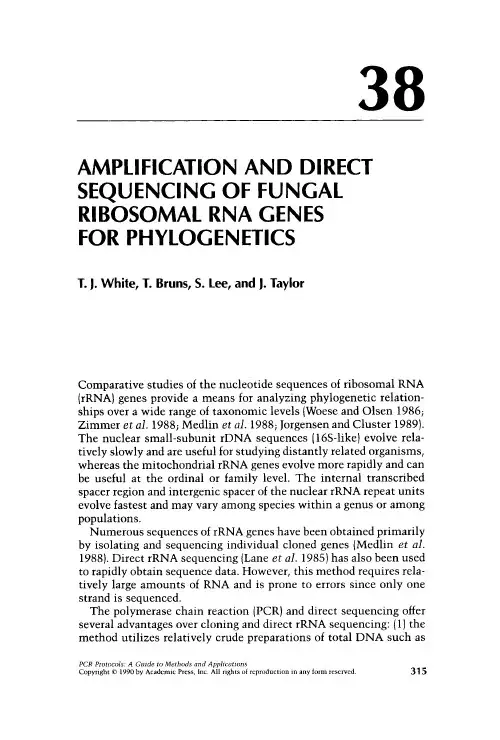
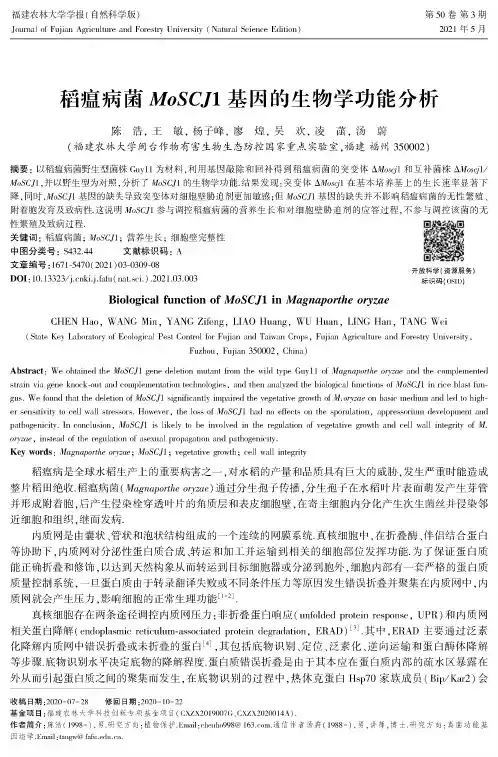
第50卷第3期2021年5月福建农林大学学报(自然科学版)Journal of Fujian Agriculture and Forestry University ( Natural Science Edition )稻瘟病菌MoSCJ l 基因的生物学功能分析陈浩,王敏,杨子峰,廖煌,吴欢,凌菡,汤蔚(福建农林大学闽台作物有害生物生态防控国家重点实验室,福建福州350002)摘要:以稻瘟病菌野生型菌株Guyll 为材料,利用基因敲除和回补得到稻瘟病菌的突变体\Moscj 1和互补菌株A Moscjl / MoSCJ l,并以野生型为对照,分析了 MoSCJ l 的生物学功能.结果发现:突变体b Moscj l 在基本培养基上的生长速率显著下 降,同时,MoSCJ l 基因的缺失导致突变体对细胞壁胁迫剂更加敏感;但MoSCJ l 基因的缺失并不影响稻瘟病菌的无性繁殖、 附着胞发育及致病性.这说明MoSCJ l 参与调控稻瘟病菌的营养生长和对细胞壁胁迫剂的应答过程,不参与调控该菌的无性繁殖及致病过程.关键词:稻瘟病菌;MoSCJ l ;营养生长;细胞壁完整性中图分类号:S432.44 文献标识码:A文章编号:l67l-5470(202l)03-0309-08DOI :l0.l3323/ki.j.fafu(nat.sci.) .202l.03.003开放科学(资源服务)标识码(OS1D )Biological function of MoSCJl in Magnaporthe oryzaeCHEN Hao, WANG Min, YANG Zifeng, L1AO Huang, WU Huan, L1NG Han, TANG Wei (State Key Laboratory of Ecological Pest Control for Fujian and Taiwan Crops , Fujian Agriculture and Forestry University ,Fuzhou, Fujian 350002, China)Abstract : We obtained the MoSCJ l gene deletion mutant from the wild type Guyll of Magnaporthe oryzae and the complemented strain via gene knock-out and complementation technologies , and then analyzed the biological functions of MoSCJ l in rice blast fun gus. We found that the deletion of MoSCJ l significantly impaired the vegetative growth of M. oryzae on basic medium and led to high er sensitivity to cell wall stressors. However , the loss of MoSCJ l had no effects on the sporulation , appressorium development and pathogenicity. 1n conclusion , MoSCJ l is likely to be involved in the regulation of vegetative growth and cell wall integrity of M. oryzae , instead of the regulation of asexual propagation and pathogenicity.Key words : Magnaporthe oryzae ; MoSCJ l ; vegetative growth ; cell wall integrity稻瘟病是全球水稻生产上的重要病害之一,对水稻的产量和品质具有巨大的威胁,发生严重时能造成 整片稻田绝收.稻瘟病菌(Magnaporthe oryzae )通过分生抱子传播,分生抱子在水稻叶片表面萌发产生芽管 并形成附着胞,后产生侵染栓穿透叶片的角质层和表皮细胞壁,在寄主细胞内分化产生次生菌丝并侵染邻 近细胞和组织,继而发病.内质网是由囊状、管状和泡状结构组成的一个连续的网膜系统.真核细胞中,在折叠酶、伴侣结合蛋白 等协助下,内质网对分泌性蛋白质合成、转运和加工并运输到相关的细胞部位发挥功能.为了保证蛋白质 能正确折叠和修饰,以达到天然构象从而转运到目标细胞器或分泌到胞外,细胞内部有一套严格的蛋白质 质量控制系统,一旦蛋白质由于转录翻译失败或不同条件压力等原因发生错误折叠并聚集在内质网中,内 质网就会产生压力,影响细胞的正常生理功能['-2].真核细胞存在两条途径调控内质网压力:非折叠蛋白响应(unfolded protein response , UPR)和内质网 相关蛋白降解(endoplasmic reticulum-associated protein degradation , ERAD)⑶.其中,ERAD 主要通过泛素 化降解内质网中错误折叠或未折叠的蛋白[4],其包括底物识别、定位、泛素化、逆向运输和蛋白酶体降解 等步骤.底物识别水平决定底物的降解程度.蛋白质错误折叠是由于其本应在蛋白质内部的疏水区暴露在 外从而引起蛋白质之间的聚集而发生,在底物识别的过程中,热休克蛋白Hsp70家族成员(Bip/Kar2)会收稿日期:2020-07-28 修回日期:2020-l0-22基金项目:福建农林大学科技创新专项基金项目(CXZX20l9007G 、CXZX20200l4A ).作者简介:陈浩(l998-),男.研究方向:植物保护.Email : chenho998@ .通信作者汤蔚( l988-),男,讲师,博士.研究方向:真菌功能基 因 组 学 .Email : tangw@ .-310-福建农林大学学报(自然科学版)第50卷与疏水区结合促进多肽链折叠,从而避免蛋白质分子的聚集[5].与Hsp70长时间作用后的底物会被E3泛素连接酶Hrdl复合物识别⑷.Hsp40/DnaJ是一个可以调节Hsp70分子伴侣活性的蛋白质家族,Hsp40s刺激Hsp70蛋白固有的弱腺苷三磷酸(adenosine triphosphate,ATP)酶活性,使其由ATP状态转变为腺苷二磷酸(adenosine diphosphate,ADP)状态,从而对底物有强亲和性,促进Hsp70与多肽底物的相互作用. Hsp70家族成员通常有多个Hsp40伴侣,其特定的配对控制Hsp70伴侣参与调控特定过程.所有Hsp40均含有高度保守的75个氨基酸J结构域,该结构域与Hsp70的ATP酶结构域相互作用,促进ATP水解[7].研究表 明,酿酒酵母(Saccharomyces cerevisiae)基因组的Hsp40/DnaJ家族中有22种蛋白质,其中包括Scjl蛋白囚.Scjl作为一种蛋白分子伴侣参与蛋白的折叠过程.已有研究发现,缺失Scjl会影响Hsp70的活性,进而影响ERAD途径中底物的识别及降解过程,最终启动细胞的凋亡程序冈.目前,有关Scjl在丝状真菌中的研究较少.本试验利用基因敲除技术获得MoSCJ l基因敲除突变体(^Moscj l),研究其营养生长、无性繁殖、致病力及对细胞壁胁迫剂的应答等情况,以探讨MoSCJ l基因在稻瘟病菌中的生物学功能,为其他病原真菌中SCJl基因的研究提供一定的参考.1材料与方法1.1供试菌株及其他材料本研究中所用稻瘟病菌野生型菌株Guyll由福建农林大学闽台作物有害生物生态防控国家重点实验室保存,△M oscj l突变体和互补菌株A Moscj l/MoSCJ l均由本试验获得.试验所用的水稻品种CO39、大麦种子均保存于福建农林大学闽台作物有害生物生态防控国家重点实验室的4冷库中.完全培养基(complete medium,CM):20x硝酸盐50mL•L_l,l000x微量兀素l mL•L_l,l000x维生素溶液l mL-LT,葡萄糖l0g-LT,蛋白胨2g-LT,水解酪蛋白l g-LT,酵母提取物l g-LT,琼脂粉l5g•L_l.基本培养基(minimal medium,MM):NaNO36g,KCl0.52g,MgSO4•7H2O0.l52g,KH2PO4 l.52g,维生素Bl0.0l g,微量元素溶液l mL,葡萄糖l0g,琼脂粉l5g.稻秆培养基(straw decoction and corn,SDC):稻秆l00g-L-l(煮沸20min,两层纱布过滤),玉米粉40g-,琼脂粉l5g-⑼.TB3培养基:水解酪蛋白3g-LT,酵母提取物3g-LT,蔗糖20%,琼脂粉l2g-L»色氨酸缺陷型合成葡萄糖基础培养基(synthetic dextrose minimal medium without tryptophan,SD-Trp):无氨基酵母氮源6.7g,D-山梨糖醇l82.2g,缺色氨酸氨基酸粉末0.74g,葡萄糖20g,琼脂粉l5g,pH5.8[l0].LB培养基:胰蛋白胨l0g-L'1,酵母提取物5g•L_1,NaCl10g-L_1,琼脂15g-L_1;酵母膏胨葡萄糖琼脂培养基(yeast extract peptone dextrose medium,YPD):葡萄糖20g-L'1,蛋白胨20g-L'1,酵母提取物10g-L'1,琼脂粉15g•L'1.试剂与仪器:潮霉素B,北京索莱宝科技有限公司;博来霉素,美国Innivogen公司;Southern杂交试剂盒,美国罗氏公司;rTaq酶、RNase,宝日医生物技术(北京)有限公司;刚果红(congo red,CR),西格玛奥德里奇(上海)贸易有限公司;microcloth,EMD Millipore公司;T100PCR仪,美国Bio-Rad公司;智能培养箱,宁波江南仪器厂;Nikon E200生物显微镜、激光扫描共聚焦显微镜,日本尼康公司;血球计数板,北京索莱宝科技有限公司;Centrifuge5420离心机,德国艾本德股份公司;PowerShot G7X Mark H相机,佳能(中国)有限公司.1.2MoScjl的系统发育分析在酵母基因组数据库中得到酿酒酵母Scjl的蛋白质序列,根据其与本试验稻瘟病菌Guyll的序列同源性比对结果,得到的同源蛋白为MoScjl.在NCBI中利用Blast比对得到一组MoScjl的同源蛋白序列,选取8个不同物种的序列在MEGA5.0软件中采用邻接法(neighbor-joining,NJ)建立系统发育树[11].1.3MoSCJ l突变体的获得1.3.1MoSCJ l基因的敲除以稻瘟病菌野生型菌株Guyll基因组为模板,以MoSCJ1-F1/MoSCJ1-F2和MoSCJ1-F3/MoSCJ1-F4(表1)两对引物对MoSCJ l基因上游和下游各1000bp左右的DNA片段进行PCR 大量扩增.与此同时,将pCX62质粒作为模板,以引物HYH-F/HYH-R(表1)对潮霉素磷酸转移酶基因全长进行PCR扩增,并对扩增结果进行纯化回收.将扩增好的MoSCJ l基因上游和下游各1000bp左右的第3期陈浩等:稻瘟病菌MoSCJ l基因的生物学功能分析-311-DNA片段及潮霉素磷酸转移酶基因全长中的目的片段进行融合PCR,获得长度约为3400bp的重组片段.以引物MoSCJ1-F1/MoSCJ1-F4(表1)对重组片段进行大量扩增,纯化回收所得片段,将回收产物用于原生质体的转化[12].用潮霉素(600愿-mf)筛选转化子.表1试验所用引物Table1Primers used in this study序列(5'f3‘)引物MoSCJl-Fl MoSCJ1-F2 MoSCJ1-F3 MoSCJ1-F4 MOSCJ1-BY-F ACTATAGGGCGAATTGGGTACCGCATCGTCTCCATGGCTGA GCGCCGAATTCGATATCAAGCTTGGCACCTAAGGCTCACTGC TGCCGACCGGGCCGGCCGGATCCGCGAAGGTGCGGTTAGAC GGTGGCGGCCGCTCTAGACGATGTTGTCAACCTCGATG CCTCAGTGAGGTAGCAAGHY-R GTATTGACCGATTCCTTGCGGTCCGAAMoSCJ1-KO-F MoSCJl-KO-R HYH-F CTGAGTTCCAGTGGGAGAGG CCTCCTTCCAGAACAGATCG TGGAGCTAGTGGAGGTCAACAATGAATGHYH-R CGGTCGGCATCTACTCTATTCCTTTGC GFP-R CGGTGGTGCAGATGAACTTCNP-SCJ1-F NP-SCJ1-R ACTCACTATAGGGCGAATTGGGTACTCAAATTGGTTGAACTTCTCCTGTCCGTACT CACCACCCCGGTGAACAGCTCCTCGCCCTTGCTCACCAACTCATCATGACCGGAGG1.3.2MoSCJ1突变体的鉴定用灭菌的牙签挑选转化子至CM培养基上,培养4d后,用CTAB法粗提转化子DNA[I3然后以粗提的转化子DNA为模板,用引物MoSCJ1-KO-F/MoSCJ1-KO-R(表1)进行PCR验证,阳性对照以野生型菌株Guy11基因组为模板,阴性对照以无菌水为模板,在阳性对照有条带、阴性对照无条带的前提下,对无条带出现的转化子进行下一步验证;以无条带的粗提转化子DNA为模板,用引物MoSCJ1-BY-F/HY-R(表1)再次进行PCR验证,阳性对照和阴性对照同上,在阳性对照、阴性对照均无条带的前提下,有条带的转化子即为突变体.1.4回补菌株的获得1.4.1回补载体的构建以野生型菌株Guy11基因组为模板,以引物NP-SCJ1-F/NP-SCJ1-R(表1)进行PCR扩增,得到长度为4247bp的片段.将其与pYF11骨架片段共同转入XK-125酵母感受态细胞中,并于SD-Trp培养基上培养24h.以酵母转化子为模板,用引物MoSCJ1-KO-F/GFP-R(表1)进行PCR验证,取有条带的酵母转化子在YPD培养基中摇培18h,提取质粒.将酵母质粒转入大肠杆菌中,再进行PCR验证,并将结果测序,获得回补载体.1.4.2回补菌株的鉴定将回补质粒转入突变体的原生质体中,培养4d后挑出转化子,在激光扫描共聚焦显微镜下用博来霉素(200jig-mL_1)进行筛选.1.5MoSCJl突变体的生物学表型分析1.5.1突变体在不同培养基上的营养生长从保菌袋中取出野生型菌株Guy11、突变体和回补菌株的存菌滤纸片分别接种于CM培养基上,于28T黑暗培养箱中培养5d.然后在各菌落边缘切取3mmX3mm 的菌块并接种于CM、MM、SDC培养基上,每个菌株设3个重复.在28弋黑暗培养箱中培养7d后,测量、记录其直径并拍照.1.5.2突变体对细胞壁胁迫剂的响应从野生型菌株Guy11、突变体和回补菌株的菌落边缘切取3mmX 3mm的菌块,分别接种于含有胁迫剂CR(400ig•mL"1)的CM培养基上,每个菌株设3个重复.在28°C 黑暗培养箱中培养7d后,测量、记录其直径并拍照,同时计算抑制率,抑制率=(空白组菌株直径-处理组菌株直径)/空白组菌株直径X100%.1.6MoSCJ l突变体的产抱量测定及分生抱子梗观察1.6.1产孢量的测定从野生型菌株Guy11、突变体和回补菌株的菌落边缘切取3mmX3mm的菌块,分别接种于SDC培养基上,每个菌株设3个重复,在28C黑暗培养箱中培养5d.刮去表面气生菌丝,置于黑光灯下培养5d后,用无菌水冲洗培养基,2层microcloth过滤于10mL离心管中得到抱子液,并最终定容・3l2・福建农林大学学报(自然科学版)第50卷至2mL.在血球计数板上统计抱子数目,并记录数据.l.6.2分生孢子梗的观察菌株培养方法同l.6.l.切2cmx2cm的菌块于载玻片上,菌丝面贴载玻片,黑光灯下培养2d后,在Nikon E200生物显微镜下观察分生抱子梗产抱情况并拍照.试验重复3次.1.7MoSCJ l突变体的附着胞萌发试验抱子液的制备方法同l.6.l,调整抱子液浓度为8xl05个・mL-l・将疏水性盖玻片置于载玻片上,向盖玻片上滴40|xL抱子液后,将载玻片放入保湿盒中,于28°C黑暗培养箱中培养,分别于4、8、l2、24h在Nikon E200生物显微镜下观察分生抱子的萌发情况并拍照,每个菌株统计l00个抱子,计算抱子萌发率和附着胞形成率.试验重复3次.1.8MoSCJ l突变体的侵染试验l.8.l水稻侵染种植感病水稻品种CO39,于26C温室中培养至三叶一心期.抱子液的制备方法同l.6.l,用血球计数板调整抱子液浓度为8xl05个・mL-1,向抱子液中加入0.2%(体积分数)明胶,混匀,用喷壶均匀地喷洒在水稻叶片上.然后将水稻置于28C黑暗培养箱中培养24h,再放在接种室培养6d,观察水稻的感染情况,统计并记录病斑等级[l4],对感病水稻叶片进行拍照.试验重复3次.l.8.2离体大麦侵染种植大麦,于温室中培养9d.抱子液的制备方法同l.6.l,用血球计数板调整抱子液浓度为8xl05个・mL-1,向抱子液中加入0.2%(体积分数)明胶.剪取长度一致的大麦叶片,滴20応抱子液于大麦叶片背部,将大麦叶片置于28C黑暗培养箱中保湿培养24h.撕取大麦背部表皮,在Nikon E200生物显微镜下观察菌丝侵染情况并拍照.试验重复3次.1.9数据处理用Excel20l0软件对试验数据进行分析和处理,用DPS数据处理系统进行单因素统计分析.2结果与分析2.1MoScjl系统发育分析系统发育树分为两大分支,MoScjl与酿酒酵母S288C具有高度同源性,且从整体来看与其他7个物种裂殖酵母(Schizosaccharomyces pombe)、拟南芥(Arabidopsis thaliana)、粘菌(Dictyostelium discoideum AX4)、果蝇(Drosophila melanogaster)、利什曼原虫(Leishmania donovani)、秀丽线虫(Caenorhabditis ele-gans)、人类(Homo sapiens)的同源蛋白序列均有相似性.由此推测这些物种的Scjl同源蛋白在功能上可能具有保守性.85---------------------------------------------------酿酒酵母Saccharomyces cerevisiae S288C98--------------------------------------------Magnaporthe oryzae---------------------------------裂殖酵母Schizosaccharomyces pombe-------------------------------拟南芥Arabidopsis thaliana99-------------------------------------------------ttW Dictyostelium discoideum AX4---------------------------------------------果蝇Drosophila melanogaster59------------------------------------------------禾Leishmania donovani88-----------------------------------------Caenorhabditis elegans91-----------------------------人类Homo sapiens图l稻瘟病菌Scjl与其他8个物种同源蛋白序列的系统发育树Fig.l Phylogenetic tree of the homologous amino acid sequences of Scjl in M.oryzae and other8species2.2MoSCJ l突变体的鉴定利用同源重组原理构建了基因敲除载体(图2A),通过原生质体转化的方法,得到具潮霉素抗性的转化子.粗提转化子基因组DNA,利用基因内部引物、臂外引物进行PCR验证,基因内部引物验证无条带、臂第3期陈浩等:稻瘟病菌MoSCJl 基因的生物学功能分析・313・外引物验证有条带的转化子即为突变体.结果显示,转化子'Mosc/1-4、'Mosc/1-22、'Mosc/1-23和'Mosc/1 - 37为符合条件的MoSCJ l 基因敲除突变体(图2B ).随机选取'Moscj l -22突变体用于后续试验.2.3 MoSCJ 1突变体的营养生长图3显示,突变体菌株在CM 和SDC 培养基上生长的直径与野生型菌株和回补菌株相比无明显差异, 而在MM 培养基上生长的直径相比于野生型菌株和回补菌株极显著缩小(P <0.01).可见,MoSCJ l 参与调 控稻瘟病菌在基本培养基上的营养生长过程.A 1 kbB MoSCJl -Guyll -----------------------——---------------------- 寻 gdDsowd 0 旨owd 寸\ hph I\Moscj\2F 2RA.MoSCJl 基因的敲除策略;B.PCR 验证结果(Guyll 为以野生型菌株为模板的阳性对照,Mock 为以无菌水为模板的阴性对照).图2 MoSCJ1基因的靶向敲除Fig.2 The targeted deletion of MoSCJl geneB ■Guyll □ ^Moscjl**表示同一培养基下不同菌株之间的差异极显著(P <0.01).图3 野生型菌株Guy11、突变体NMoscj1、回补菌株^Moscj1/MoSCJ1在CM 、MM 、SDC 培养基上的营养生长情况(A )和菌落直径(B )Fig.3 Vegetative growth (A) and colony diameters ( B) of Guyl 1, 'Moscjl and 'Moscjl /MoSCJl on CM , MM, SDC plates2.4 MoSCJ 1突变体对细胞壁胁迫剂的响应相比于野生型菌株和回补菌株,突变体对CR 更加敏感(图4),抑制率呈现极显著差异(P <0. 01).这 说明MoSCJ l 参与调控稻瘟病菌对细胞壁胁迫剂的应答过程.CK 为不加入胁迫剂的对照组;CR 为加入刚果红的处理组.**表示差异极显著(P <0.01).图4 野生型菌株Guy11、突变体\Moscj1、回补菌株^Moscj1/MoSCJ1在含有CR 的CM 培养基上的生长情况(A )和抑制率(B )Fig.4 The growth (A ) and inhibition rate of Guyll , 'Moscjl and 'Mosc/l/MoSCJl on CM plates containingCR・3l4・福建农林大学学报(自然科学版)第 50 卷2.5 MoSCJ l 突变体的无性繁殖结果显示,野生型菌株、突变体和回补菌株均能产生大量抱子(图5A ),且三者之间的产抱量无显著 差异(图5B ).由此推测MoSCJ l 不参与调控稻瘟病菌的无性繁殖过程.AB 二 A n u 204 O 1612Guyl 1 bMoscj\ NMoscj'l MoSCJX 菌株类型旨owaUUSOW 己。
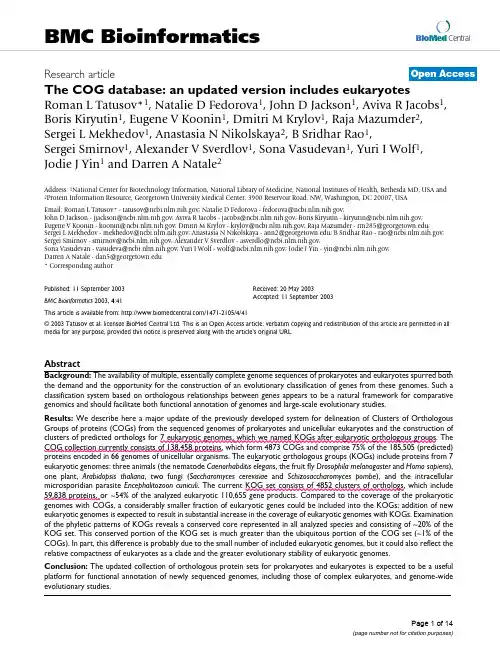
Bio Med CentralBMC BioinformaticsResearch articleThe COG database: an updated version includes eukaryotesRoman L Tatusov*1, Natalie D Fedorova 1, John D Jackson 1, Aviva R Jacobs 1,Boris Kiryutin 1, Eugene V Koonin 1, Dmitri M Krylov 1, Raja Mazumder 2, Sergei L Mekhedov 1, Anastasia N Nikolskaya 2, B Sridhar Rao 1,Sergei Smirnov 1, Alexander V Sverdlov 1, Sona Vasudevan 1, Yuri I Wolf 1, Jodie J Yin 1 and Darren A Natale 2Address: 1National Center for Biotechnology Information, National Library of Medicine, National Institutes of Health, Bethesda MD, USA and 2Protein Information Resource, Georgetown University Medical Center, 3900 Reservoir Road, NW, Washington, DC 20007, USAEmail: Roman L Tatusov*-tatusov@; Natalie D Fedorova -fedorova@;John D Jackson -jjackson@; Aviva R Jacobs -jacobs@; Boris Kiryutin -kiryutin@; Eugene V Koonin -koonin@; Dmitri M Krylov -krylov@; Raja Mazumder -rm285@;Sergei L Mekhedov -mekhedov@; Anastasia N Nikolskaya -ann2@; B Sridhar Rao -rao@; Sergei Smirnov -smirnov@; Alexander V Sverdlov -asverdlo@;Sona Vasudevan -vasudeva@; Yuri I Wolf -wolf@; Jodie J Yin -yin@; Darren A Natale -dan5@ * Corresponding author AbstractBackground: The availability of multiple, essentially complete genome sequences of prokaryotes and eukaryotes spurred both the demand and the opportunity for the construction of an evolutionary classification of genes from these genomes. Such a classification system based on orthologous relationships between genes appears to be a natural framework for comparative genomics and should facilitate both functional annotation of genomes and large-scale evolutionary studies.Results: We describe here a major update of the previously developed system for delineation of Clusters of Orthologous Groups of proteins (COGs) from the sequenced genomes of prokaryotes and unicellular eukaryotes and the construction of clusters of predicted orthologs for 7 eukaryotic genomes, which we named KOGs after eukaryotic orthologous groups. The COG collection currently consists of 138,458 proteins, which form 4873 COGs and comprise 75% of the 185,505 (predicted)proteins encoded in 66 genomes of unicellular organisms. The eukaryotic orthologous groups (KOGs) include proteins from 7eukaryotic genomes: three animals (the nematode Caenorhabditis elegans , the fruit fly Drosophila melanogaster and Homo sapiens ),one plant, Arabidopsis thaliana , two fungi (Saccharomyces cerevisiae and Schizosaccharomyces pombe ), and the intracellular microsporidian parasite Encephalitozoon cuniculi . The current KOG set consists of 4852 clusters of orthologs, which include 59,838 proteins, or ~54% of the analyzed eukaryotic 110,655 gene products. Compared to the coverage of the prokaryotic genomes with COGs, a considerably smaller fraction of eukaryotic genes could be included into the KOGs; addition of new eukaryotic genomes is expected to result in substantial increase in the coverage of eukaryotic genomes with KOGs. Examination of the phyletic patterns of KOGs reveals a conserved core represented in all analyzed species and consisting of ~20% of the KOG set. This conserved portion of the KOG set is much greater than the ubiquitous portion of the COG set (~1% of the COGs). In part, this difference is probably due to the small number of included eukaryotic genomes, but it could also reflect the relative compactness of eukaryotes as a clade and the greater evolutionary stability of eukaryotic genomes.Conclusion: The updated collection of orthologous protein sets for prokaryotes and eukaryotes is expected to be a useful platform for functional annotation of newly sequenced genomes, including those of complex eukaryotes, and genome-wide evolutionary studies.Published: 11 September 2003BMC Bioinformatics 2003, 4:41Received: 20 May 2003Accepted: 11 September 2003This article is available from: /1471-2105/4/41© 2003 Tatusov et al; licensee BioMed Central Ltd. This is an Open Access article: verbatim copying and redistribution of this article are permitted in all media for any purpose, provided this notice is preserved along with the article's original URL.本页已使用福昕阅读器进行编辑。
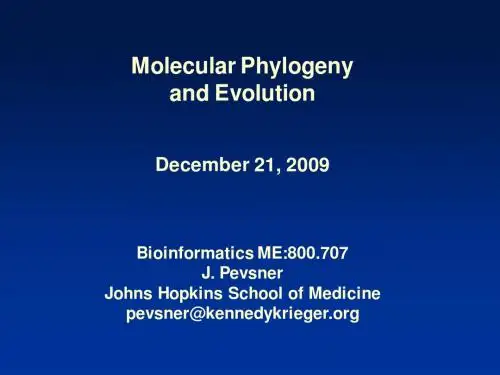
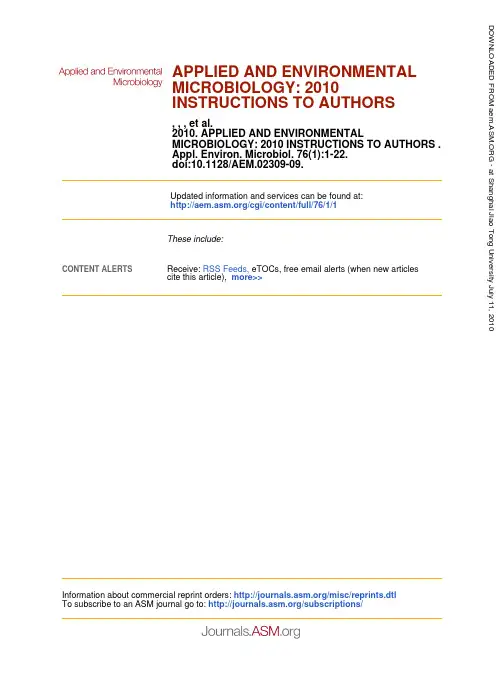
doi:10.1128/AEM.02309-09.Appl. Environ. Microbiol. 76(1):1-22. .MICROBIOLOGY: 2010 INSTRUCTIONS TO AUTHORS APPLIED AND ENVIRONMENTAL2010. , , , et al.INSTRUCTIONS TO AUTHORSMICROBIOLOGY: 2010APPLIED AND ENVIRONMENTAL/cgi/content/full/76/1/1Updated information and services can be found at:These include:CONTENT ALERTSmore>>cite this article), eTOCs, free email alerts (when new articles RSS Feeds,Receive:/subscriptions/To subscribe to an ASM journal go to: /misc/reprints.dtlInformation about commercial reprint orders: at Shanghai Jiao Tong University July 11, 2010 - DOWNLOADED FROMAPPLIED AND ENVIRONMENTAL MICROBIOLOGY2010INSTRUCTIONS TO AUTHORS*SCOPEApplied and Environmental Microbiology (AEM)pub-lishes descriptions of all aspects of applied microbial research,basic research on microbial ecology,and research of a genetic and molecular nature that fo-cuses on microbial topics of practical value.Research must address salient microbiological principles,fun-damental microbial processes,or basic questions in applied or environmental microbiology.Topics that are considered include microbiology in relation to foods,agriculture,industry,biotechnology,public health,plants,and invertebrates and basic biological properties of bacteria,fungi,algae,protozoa,and other simple eukaryotic organisms as related to mi-crobial ecology.Manuscripts should report new and significant findings that advance the understanding of microbiology and upon which other scientists may build.To best serve its readership,the journal must accept only those papers that are most significant to the field of applied and environmental microbiology.Thus,the editors will reject manuscripts that,while scientifically sound,represent only incremental exten-sions of other studies,are mainly confirmatory,or do not pursue a question in sufficient depth.The biodegradation section describes novel microbial processes for alteration,removal,or utilization of envi-ronmental or anthropogenic chemicals.Papers in the biotechnology section describe the use and modification of organisms in order to achieve so-cially beneficial objectives.The environmental microbiology section covers manuscripts that focus on research related to microor-ganisms in the environment.This is distinct from the microbial ecology section,which focuses on ecological relationships,such as interactions among organisms,their structure and functional role in an ecosystem,and community level studies.Thus,the environmental mi-crobiology section features articles that focus on specific organisms in the environment,rather than a whole com-munity,as well as those in which the study is not focused on implied or stated underlying ecological relationships.The enzymology and protein engineering section cov-ers the structure and function of environmentally or industrially significant proteins and how they can be modified to achieve practical catalytic objectives.Included in the evolutionary and genomic microbiol-ogy section are papers detailing newly described evolu-tionary processes and evolutionary relationships among microorganisms.Topics include genomic analysis of es-tablished microorganisms and metagenomic investiga-tion of microbial populations in the environment.The food microbiology section covers manuscripts dealing with all aspects of food microbiology,including microbial food safety,microbial ecology of foods,pre-dictive food microbiology,probiotics,food fermenta-tions,and food spoilage.The genetics and molecular biology section includes papers describing genetic organization,expression,mu-tation,and repair in organisms with environmental or practical significance.Manuscripts for the geomicrobiology section must em-phasize the role of microorganisms in geobiochemical processes in terrestrial or aquatic ecosystems,including subsurface,aquifer,and oceanic environments.Topics include mineralization,the use of inorganic ions in en-ergy metabolism,and growth in extreme environments.Manuscripts focused on geological processes with only marginal links to microbiology will not qualify for AEM.Invertebrate microbiology manuscripts should address interactions between invertebrates and microorganisms,ranging from commensalism and mutualism to parasit-ism and pathogenicity.Manuscripts describing work dealing with the metabolites or toxins from animal,plant,or insect cells or the physiology of such cells are not suitable for AEM unless the work concerns a micro-bial community or individual microorganisms.New microbiological methods must provide novel avenues to address fundamental biological questions and will be considered for publication in AEM when accompanied by a demonstrated application.Descrip-tions of the application of previously described technol-ogies,including the cloning,amplification,and expres-sion of “foreign”genes,to a new genus or species of microbe will generally not be considered for indepen-dent publication.Manuscripts that describe the con-struction of engineered strains for innovative process application,development,or enhancement must present results to authenticate the utility,superiority,and uniqueness of such strains.The microbial ecology section covers a wide range of topics on the ecology of microorganisms,including cul-ture-independent molecular assessments that provide new insights into (i)the structure-function relationships of microorganisms,(ii)the impact of in situ conditions on community structure,or (iii)the effect of changes in microbial community composition on ecosystem func-tion.Archival phylogenetic snapshots that do not pro-vide such insights are not acceptable for publication in AEM.Manuscripts submitted to the mycology section should be clearly of a microbiological nature and may deal with basic biology,biochemistry,genetics,or physiology of fungi,molds,yeasts,or algae.Papers dealing purely with taxonomy or phylogeny,with fungal or algal structure,or*Instructions to Authors are published annually in the January issue.A separate html version,which is updated throughout the year,is at /misc/ifora.dtl .1A PPLIED AND E NVIRONMENTAL M ICROBIOLOGY ,January 2010,p.1–22Vol.76,No.10099-2240/10/$12.00doi:10.1128/AEM.02309-09Copyright ©2010,American Society for Microbiology.All Rights Reserved.at Shanghai Jiao Tong University July 11, 2010 - DOWNLOADED FROMwith metabolism/alteration of metabolites/toxins by ani-mal,plant,or insect cells,tissues,or organisms are not suitable.Documentation of the distribution/occurrence of toxins or metabolites in natural samples(foods,cere-als,grains,and soils,etc.)is suitable if the work includes studies involving the isolation,occurrence,or enumera-tion of the responsible microbes in these samples.The chemical or biochemical elucidation of metabolite or toxin structures is suitable if the work includes aspects of the enzymology or biosynthesis of these compounds. The physiology section addresses questions about how organisms adapt to changes in their environment,in-cluding bioenergetics,stress,starvation,metabolic chal-lenges,and responses to nutritional variation.The plant microbiology section covers manuscripts dealing with all aspects of plant-microorganism interac-tions,including symbiotic and rhizosphere bacteria and phytopathogenic microorganisms.The public health microbiology section focuses on manuscripts that describe the various aspects of the be-havior of environmentally transmitted microorganisms that cause human disease.These include,but are not limited to,microorganisms transmitted through water, air,soil,and/or environmental surfaces.ASM publishes a number of different journals cover-ing various aspects of thefield of microbiology.Each journal has a prescribed scope which must be considered in determining the most appropriate journal for each manuscript.The following guidelines may be of assis-tance.(i)AEM will consider manuscripts describing proper-ties of enzymes and proteins that are produced by either wild-type or genetically engineered microorganisms and that are significant or have potential significance in in-dustrial or environmental settings.Studies dealing with basic biological phenomena of enzymes or proteins or in which enzymes have been used in investigations of basic biological functions are more appropriate for the Journal of Bacteriology.(ii)AEM will consider papers which describe the use of antimicrobial agents as tools for elucidating aspects of applied and environmental microbiology.Other papers dealing with antimicrobial agents,including manuscripts dealing with the biosynthesis and metabolism of such agents,are more appropriate for Antimicrobial Agents and Chemotherapy.(iii)AEM will consider manuscripts that concern bacte-riophages or other viruses in relation to the environment, public health,or industrial microbiology.Papers that pri-marily concern attachment and intracellular replication of viruses,virus interactions with host metabolism,virus struc-ture,or virus genomics are more appropriate for the Jour-nal of Bacteriology or the Journal of Virology.(iv)Manuscripts dealing with the immune system or with topics of basic medical interest or oral microbiology are more appropriate for Infection and Immunity.Re-ports of clinical investigations and environmental biol-ogy applied to hospitals should be submitted to the Jour-nal of Clinical Microbiology.(v)AEM and Eukaryotic Cell(EC)accept manuscripts on population dynamics and the ecology of eukaryotic microbes.Studies of microbial communities and of mi-crobial populations with identified economic or ecolog-ical significance,e.g.,plant pathogens or symbionts,are usually more appropriate for AEM.Studies of single species of eukaryotes,especially“model”organisms or those without identified economic or ecological impor-tance,are usually more appropriate for EC.(vi)Manuscripts dealing with the purification and characterization of enzymes or cloning of genes that have already been extensively described for other or-ganisms will be considered for publication only if they offer experimentally supported new insights into the biological role,properties,or applications of these enzymes.Descriptions of genes or enzymes that differ only in minor ways from the prototypes are not suit-able for AEM.Questions about these guidelines may be directed to the editor in chief of the journal being considered.If transfer to another ASM journal is recommended by an editor,the corresponding author will be contacted. Note that a manuscript rejected by one ASM journal on scientific grounds or on the basis of its general suit-ability for publication is considered rejected by all other ASM journals.EDITORIAL POLICYUse of Microbiological InformationThe Council Policy Committee(CPC)of the Ameri-can Society for Microbiology affirms the long-standing position of the Society that microbiologists will work for the proper and beneficent application of science and will call to the attention of the public or the appropriate authorities misuses of microbiology or of information derived from microbiology.ASM members are obligated to discourage any use of microbiology contrary to the welfare of humankind,including the use of microbes as biological weapons.Bioterrorism violates the fundamen-tal principles expressed in the Code of Ethics of the Society and is abhorrent to ASM and its members. ASM recognizes that there are valid concerns regard-ing the publication of information in scientific journals that could be put to inappropriate use as described in the CPC resolution mentioned above.Members of the ASM Publications Board will evaluate the rare manuscript that might raise such issues during the review process. However,as indicated elsewhere in these Instructions, research articles must contain sufficient detail,and material/information must be made available,to permit the work to be repeated by others.Supply of ma-terials should be in accordance with laws and regula-tions governing the shipment,transfer,possession,and use of biological materials and must be for legitimate, bonafide research needs.Links to,and information re-garding,these laws and regulations can be found at22010AEM INSTRUCTIONS TO AUTHORS A PPL.E NVIRON.M ICROBIOL.at Shanghai Jiao Tong University July 11, 2010 -DOWNLOADED FROM/under the Public Policy tab.We ask that authors pay particular attention to the NSAR Select Agent/Toxin list on the CDC website http://www /index.html and the NSABB criteria for identifying dual use research of concern in the report “Proposed Framework for the Oversight of Dual Use Life Sciences Research:Strategies for Minimizing the Potential Misuse of Research Information”on the Office of Biotechnology Activities website /biosecurity/(pages17–22).Ethical GuidelinesAuthors are expected to adhere to the highest ethical standards.The following sections of these Instructions include detailed information about ASM’s ethical stan-dards.Failure to comply with the policies described in these Instructions may result in a letter of reprimand,a suspension of publishing privileges in ASM journals, and/or notification of the authors’institutions.Authors employed by companies whose policies do not permit them to comply with the ASM policies may be sanc-tioned as individuals and/or ASM may refuse to consider manuscripts having authors from such companies.The ASM Publications Board wishes to clarify the following in particular.Plagiarism.Misappropriating another person’s intel-lectual property constitutes plagiarism.This includes copy-ing sentences or paragraphs verbatim(or almost verbatim) from someone else’s work,even if the original work is cited in the references.The NIH ORI publication“Avoiding Plagiarism,Self-Plagiarism,and Other Questionable Writ-ing Practices:a Guide to Ethical Writing”(http://ori.dhhs .gov/education/products/plagiarism/)can help authors identify questionable writing practices.Plagiarism is not limited to the text;it can involve any part of the manuscript,includingfigures and tables,in which material is copied from another publication with-out permission and attribution.An author may not reuse his or her own previously published work without attri-bution;this is considered self-plagiarism.Primary publication.Manuscripts submitted to the journal must represent reports of original research,and the original data must be available for review by the editor if necessary.By submission of a manuscript to the journal,the authors guarantee that they have the authority to publish the work and that the manuscript,or one with substan-tially the same content,was not published previously,is not being considered or published elsewhere,and was not rejected on scientific grounds by another ASM jour-nal.It is incumbent upon the author to acknowledge any prior publication,including his/her own articles,of the data contained in a manuscript submitted to an ASM journal.A copy of the relevant work should be submitted with the paper as supplemental material.Whether the material constitutes the substance of a paper and there-fore renders the manuscript unacceptable for publica-tion is an editorial decision.In brief,a paper is not acceptable for submission to an ASM journal if it,or its substance,has been published/ posted in:•A serial,periodical,or book•A conference report or symposium proceedings•A technical bulletin or company white paper•A nonpersonal website•Any other retrievable sourceThe following do not preclude submission to,or pub-lication by,an ASM journal,as long as the posted data do not constitute the substance of a submission:•Posting of a method/protocol on a nonpersonal website•Posting of a limited amount of original data on a personal/university/corporate website or websites of small collaborative groups working on a problem •Posting of unpublished sequence data on the Inter-net(the URL where the sequence is posted should be included in the text)•Preliminary disclosures of researchfindings as meeting posters,webcast as meeting presentations, or published in abstract form as adjuncts to a meet-ing,e.g.,part of a program•Posting of theses and dissertations on a personal/ university-hosted websiteAvailability of materials.By publishing in the jour-nal,the authors agree that,subject to requirements or limitations imposed by laws or governmental regulations of the United States,any DNAs,viruses,microbial strains,mutant animal strains,cell lines,antibodies,and similar materials newly described in the article are avail-able from a national collection or will be made available in a timely fashion,at reasonable cost,and in limited quantities to members of the scientific community for noncommercial purposes.The authors guarantee that they have the authority to comply with this policy either directly or by means of material transfer agreements through the owner.Similarly,the authors agree to make available com-puter programs,originating in the authors’laboratory, that are the only means of confirming the conclusions reported in the article but that are not available com-mercially.The program(s)and suitable documentation regarding its(their)use may be provided by any of the following means:(i)as a program transmitted via the Internet,(ii)as an Internet server-based tool,or(iii)as a compiled or assembled form on a suitable medium (e.g.,magnetic or optical).It is expected that the mate-rial will be provided in a timely fashion and at reason-able cost to members of the scientific community for noncommercial purposes.The authors guarantee that they have the authority to comply with this policy either directly or by means of material transfer agreements through the owner.V OL.76,20102010AEM INSTRUCTIONS TO AUTHORS3at Shanghai Jiao Tong University July 11, 2010 -DOWNLOADED FROMPermissions.The corresponding author is responsi-ble for obtaining permission from both the original au-thor and the original publisher(i.e.,the copyright owner)to reproduce or modifyfigures(including maps) and tables and to reproduce text(in whole or in part) from previous publications.Permission(s)must be obtained no later than the modification stage.The original signed permission(s) must be identified as to the relevant item in the ASM manuscript(e.g.,“permissions for Fig.1in AEM00123-10”)and submitted to the ASM production editor on request.In addition,a statement indicating that the ma-terial is being reprinted with permission must be in-cluded in the relevantfigure legend or table footnote of the manuscript.Reprinted text must be enclosed in quo-tation marks,and the permission statement must be included as running text or indicated parenthetically. It is expected that the authors will provide written assurance that permission to cite unpublished data or personal communications has been granted.For supple-mental material intended for posting by ASM(see“Sup-plemental Material”),if the authors of the AEM manu-script are not also the owners of the supplemental material,the corresponding author must send to ASM signed permission from the copyright owner that allows posting of the material,as a supplement to the article,by ASM.The corresponding author is also responsible for incorporating in the supplemental material any copy-right notices required by the owner.Authorship.All authors of a manuscript must have agreed to its submission and are responsible for its content(initial submission and any subsequent ver-sions),including appropriate citations and acknowledg-ments,and must also have agreed that the correspond-ing author has the authority to act on their behalf in all matters pertaining to publication of the manuscript.The corresponding author is responsible for obtaining such agreements and for informing the coauthors of the manuscript’s status throughout the submission,review, and publication process.Submitting a paper before all coauthors have read and approved it is considered an ethical violation,as is failure to credit someone who qualifies as a coauthor;however,ASM does not itself investigate or attempt to resolve authorship disputes. An author is one who made a substantial contribution to the overall design and execution of the experiments; therefore,ASM considers all authors responsible for the entire paper.Individuals who provided assistance, e.g.,supplied strains or reagents or critiqued the paper, need not be listed as authors but may be recognized in the Acknowledgments section.A study group,surveillance team,working group,con-sortium,or the like(e.g.,the Active Bacterial Core Sur-veillance Team)may be listed as a coauthor in the byline if its contributing members satisfy the requirements for authorship and accountability as described in these In-structions.The names(and institutional affiliations,if desired)of the contributing members only may be given in a footnote linked to the study group name in the byline or as a separate paragraph in the Acknowledg-ments section.If the contributing members of the group associated with the work do not fulfill the criteria of substantial contribution to and responsibility for the paper,the group may not be listed in the author byline.Instead,it and the names of its contributing members may be listed in the Acknowledgments section.All authors must agree to the order in which their names are listed in the byline.Statements regarding equal contributions by two or more authors(e.g.,X.J. and Y.S.contributed equally to...)are permitted as footnotes to bylines and must be agreed to by all of the authors.Other statements of attribution may be in-cluded in the Acknowledgments section.A change in authorship(order of listing,addition or deletion of a name,or corresponding author designa-tion)after submission of the manuscript will be imple-mented only after receipt of signed statements of agree-ment from all parties involved.Disputes about authorship may delay or prevent re-view and/or publication of the manuscript.Should the individuals involved be unable to reach an accord,re-view and/or publication of the manuscript can proceed only after the matter is investigated and resolved by the authors’institution(s)and an official report of such and signed statements of agreement are provided to ASM. Conflict of interest.All authors are expected to dis-close,in the manuscript submittal letter,any commercial affiliations as well as consultancies,stock or equity in-terests,and patent-licensing arrangements that could be considered to pose a conflict of interest regarding the submitted manuscript.(Inclusion of a company name in the author address lines of the manuscript does not constitute disclosure.)Details of the disclosure to the editor will remain confidential.However,it is the re-sponsibility of authors to provide,in the Acknowledg-ments section,a general statement disclosingfinancial or other relationships that are relevant to the study.Exam-ples of potentially conflicting interests that should be disclosed include relationships that might detract from an author’s objectivity in presentation of study results and interests whose value would be enhanced by the results presented.All funding sources for the project, institutional and corporate,should be credited in the Acknowledgments section,as described below.In addi-tion,if a manuscript concerns a commercial product,the manufacturer’s name must be indicated in the Materials and Methods section or elsewhere in the text,as appro-priate,in an obvious manner.CopyrightTo maintain and protect the Society’s ownership and rights and to continue to afford scientists the opportunity to publish in high-quality journals,ASM requires the corresponding author to sign a copyright transfer agree-ment on behalf of all the authors on acceptance.Unless42010AEM INSTRUCTIONS TO AUTHORS A PPL.E NVIRON.M ICROBIOL.at Shanghai Jiao Tong University July 11, 2010 -DOWNLOADED FROMthis agreement is executed(without changes and/or ad-denda),ASM will not publish the article.In the copyright transfer agreement signed by an au-thor,ASM grants to that author(and coauthors)the right to republish discrete portions of his/her(their) article in any other publication(print,CD-ROM,and other electronic forms)of which he/she is(they are)the author(s)or editor(s),on the condition that appropriate credit is given to the original ASM publication.This republication right also extends to posting on a host computer to which there is access via the Internet.Ex-cept as indicated below,significant portions of the article may not be reprinted/posted without ASM’s prior writ-ten permission,however,as this would constitute dupli-cate publication.Authors may post their own published articles on their personal or university-hosted(but not corporate,gov-ernment,or similar)websites without ASM’s prior writ-ten permission provided that appropriate credit is given (i.e.,the copyright lines shown at the top of thefirst page).The copyright transfer agreement asks that authors who were ernment employees and who wrote the article as part of their employment duties be identi-fied.This is because works authored solely by such U.S. government employees are not subject to copyright pro-tection,so there is no copyright to be transferred.The other provisions of the copyright transfer agreement, such as author representations of originality and author-ity to enter into the agreement,apply to ern-ment employee-authors as well as to other authors. Copyright for supplemental material(see“Supple-mental Material”)remains with the author,but a license permitting the posting by ASM will be sent,along with the article copyright transfer agreement,to the corre-sponding author for signing at the acceptance stage.(If the author of the article is not also the copyright owner of the supplemental material,the corresponding author must send to ASM signed permission from the owner that allows posting of the material,as a supplement to the article,by ASM.The corresponding author is also responsible for incorporating into the supplemental ma-terial any copyright notices required by the owner.) ASM also requires that copyright transfer agreements be signed for cover artwork/photographs.Funding Agency RepositoriesThe National Institutes of Health(NIH)requests that its grantee and intramural authors provide copies of their accepted manuscripts to PubMed Central(PMC) for posting in the PMC Public Access Repository.How-ever,AEM authors are automatically in compliance with this policy and need take no action themselves.For the past several years,ASM has deposited in PubMed Cen-tral all publications from all ASM journals.Further, ASM policy is that all primary research articles are made available to everyone,free,6months after publication through PubMed Central,HighWire,and international PubMed Central-like repositories.By having initiated these policies,ASM is in full compliance with NIH pol-icy.For more information,see http://publicaccess.nih .gov/.ASM also allows AEM authors whose work was supported by similar funding agencies that have public access requirements like those of the NIH(e.g.,the Wellcome Trust)to post their accepted manuscripts in publicly accessible electronic repositories maintained by those funding agencies.If a funding agency does not itself maintain such a site,then ASM allows the author to fulfill that requirement by depositing the manuscript (not the typeset article)in an appropriate institutional or subject-based open repository established by a govern-ment or noncommercial entity.Since ASM makes thefinal,typeset articles from its primary-research journals available free of charge on the ASM Journals and PMC websites6months afterfinal publication,ASM recommends that when submitting the accepted manuscript to PMC or a similar public access site,the author specify that the posting release date for the manuscript be no earlier than6months after pub-lication of the typeset article by ASM.Use of Human Subjects or Animals in ResearchThe use of human subjects or other animals for re-search purposes is regulated by the federal government and individual institutions.Manuscripts containing in-formation related to human or animal use should clearly state that the research has complied with all relevant federal guidelines and institutional policies.Copies of these guidelines and policy statements must be available for review by the editor if necessary.Nucleotide and Amino Acid SequencesNewly determined nucleotide and/or amino acid se-quence data must be deposited and GenBank/EMBL/ DDBJ accession numbers must be included in the manu-script no later than the modification stage of the review process.It is expected that the sequence data will be released to the public no later than the publication(on-line posting)date of the accepted manuscript.The ac-cession numbers should be included in a separate para-graph at the end of the Materials and Methods section for full-length papers or at the end of the text for short-form papers.If conclusions in a manuscript are based on the analysis of sequences and a GenBank/EMBL/DDBJ accession number is not provided at the time of the review,authors should provide the sequence data as supplemental material.It is expected that,when previously published se-quence accession numbers are cited in a manuscript,the original citations(e.g.,journal articles)will be included in the References section when possible or reasonable. Authors are also expected to do elementary searches and comparisons of nucleotide and amino acid se-quences against the sequences in standard databases (e.g.,GenBank)immediately before manuscripts are submitted and again at the proof stage.Analyses should specify the database,and the date ofV OL.76,20102010AEM INSTRUCTIONS TO AUTHORS5at Shanghai Jiao Tong University July 11, 2010 -DOWNLOADED FROM。
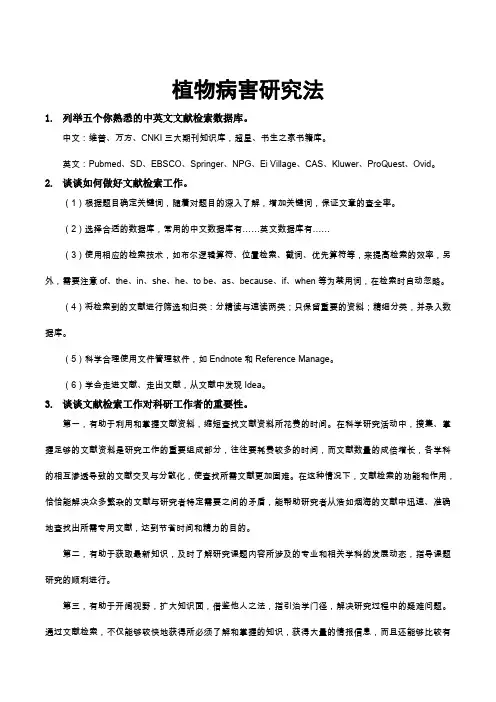
植物病害研究法1.列举五个你熟悉的中英文文献检索数据库。
中文:维普、万方、CNKI三大期刊知识库,超星、书生之家书籍库。
英文:Pubmed、SD、EBSCO、Springer、NPG、Ei Village、CAS、Kluwer、ProQuest、Ovid。
2.谈谈如何做好文献检索工作。
(1)根据题目确定关键词,随着对题目的深入了解,增加关键词,保证文章的查全率。
(2)选择合适的数据库,常用的中文数据库有……英文数据库有……(3)使用相应的检索技术,如布尔逻辑算符、位臵检索、截词、优先算符等,来提高检索的效率,另外,需要注意of、the、in、she、he、to be、as、because、if、when等为禁用词,在检索时自动忽略。
(4)将检索到的文献进行筛选和归类:分精读与速读两类;只保留重要的资料;精细分类,并录入数据库。
(5)科学合理使用文件管理软件,如Endnote和Reference Manage。
(6)学会走进文献、走出文献,从文献中发现Idea。
3.谈谈文献检索工作对科研工作者的重要性。
第一,有助于利用和掌握文献资料,缩短查找文献资料所花费的时间。
在科学研究活动中,搜集、掌握足够的文献资料是研究工作的重要组成部分,往往要耗费较多的时间,而文献数量的成倍增长,各学科的相互渗透导致的文献交叉与分散化,使查找所需文献更加固难。
在这种情况下,文献检索的功能和作用,恰恰能解决众多繁杂的文献与研究者特定需要之间的矛盾,能帮助研究者从浩如烟海的文献中迅速、准确地查找出所需专用文献,达到节省时间和精力的目的。
第二,有助于获取最新知识,及时了解研究课题内容所涉及的专业和相关学科的发展动态,指导课题研究的顺利进行。
第三,有助于开阔视野,扩大知识面,借鉴他人之法,指引治学门径,解决研究过程中的疑难问题。
通过文献检索,不仅能够较快地获得所必须了解和掌握的知识,获得大量的情报信息,而且还能够比较有关文献的异同优劣,明确学术源流,达到正确鉴别、准确选择所需文献资料的目的。

SCI收录关于微生物发酵刊物Abbreviated Journal Title Impact FactorADV APPL MICROBIOL 1.821ADV MICROB PHYSIOL 4.9ANN MICROBIOL 0.315ANNU REV MICROBIOL 14.362ANTIMICROB AGENTS CH 4.39APPL BIOCHEM MICRO+ 0.51APPL ENVIRON MICROB 4.004APPL MICROBIOL BIOT 2.475AQUA T MICROB ECOL 2.385ARCH MICROBIOL 1.838BIOMED MICRODEVICES 3.073BIOMICROFLUIDICSBMC MICROBIOL 2.982BRAZ J MICROBIOL 0.339CAN J MICROBIOL 1.286CELL HOST MICROBECELL MICROBIOL 5.293CLIN HEMORHEOL MICRO 0.977CLIN MICROBIOL INFEC 2.98CLIN MICROBIOL REV 15.764COMP IMMUNOL MICROB 0.81CRIT REV MICROBIOL 3.368CURR MICROBIOL 1.167CURR OPIN MICROBIOL 7.654CURR TOP MICROBIOL 4.411ENVIRON MICROBIOL 4.929ENZYME MICROB TECH 1.969EUR J CLIN MICROBIOL 2.309FEMS MICROBIOL ECOL 3.039FEMS MICROBIOL LETT 2.274FEMS MICROBIOL REV 9.25FOLIA MICROBIOL 0.989FOOD MICROBIOL 2.039FUTURE MICROBIOL 0.645GEOMICROBIOL J 1.655IEE P-MICROW ANTEN P 0.489IEEE MICRO 1.701IEEE MICROW MAG 1.18IEEE MICROW WIREL CO 1.725IEEE T MICROW THEORY 1.907IET MICROW ANTENNA PINT J ANTIMICROB AG 2.338 INT J FOOD MICROBIOL 2.581 INT J MED MICROBIOL 2.524 INT J RF MICROW C E 0.291INT MICROBIOL 2.617J ANTIMICROB CHEMOTH 4.038 J APPL MICROBIOL 2.501J BASIC MICROB 0.991J CLIN MICROBIOL 3.708J ELECTRON MICROSC 1.172J EUKARYOT MICROBIOL 1.525 J GEN APPL MICROBIOL 0.925 J IND MICROBIOL BIOT 1.681J MED MICROBIOL 2.091J MICROBIOL 2.05J MICROBIOL BIOTECHN 2.062 J MICROBIOL METH 2.153J MICROELECTROMECH S 1.964 J MICROENCAPSUL 1.168J MICROLITH MICROFAB 0.986 J MICROMECH MICROENG 1.93 J MICRO-NANOLITH MEMJ MICROPALAEONTOL 0.258J MICROSC-OXFORD 1.565J MOL MICROB BIOTECH 2.588 J RECONSTR MICROSURG 0.722 LETT APPL MICROBIOL 1.623 MAR MICROPALEONTOL 1.505 MED MICROBIOL IMMUN 1.537 METHOD MICROBIOL 0.6 MICRO 0.172MICRO NANO LETT 0.63 MICROB CELL FACT 0.547 MICROB DRUG RESIST 1.543 MICROB ECOL 2.558MICROB PA THOGENESIS 2.064 MICROBES INFECT 2.523 MICROBIOL IMMUNOL 1.295 MICROBIOL MOL BIOL R 14.629 MICROBIOL RES 1.535 MICROBIOLOGY+ 0.597 MICROBIOL-SGM 3.11 MICROCHEM J 1.8 MICROCHIM ACTA 1.959MICROCIRCULA TION 2.955MICROELECTRON ENG 1.503MICROELECTRON INT 0.571MICROELECTRON J 0.609MICROELECTRON RELIAB 1.011MICROFLUID NANOFLUID 2.241MICROGRA VITY SCI TEC 0.467MICROLITHOGR WORLD 0.29MICRON 1.651MICROPALEONTOLOGY 0.647MICROPOR MESOPOR MA T 2.21MICROPROCESS MICROSY 0.524MICROSC MICROANAL 1.941MICROSC RES TECHNIQ 1.644MICROSCALE THERM ENG 1.417MICROSURG 1.07MICROSYST TECHNOL 0.912MICROV ASC RES 2.365MICROW OPT TECHN LET 0.631MICROWA VE J 0.191MICROWA VES RF 0.054MOL MICROBIOL 5.462MOL PLANT MICROBE IN 4.275NANOSC MICROSC THERM 0.538NA T REV MICROBIOL 14.959NEW MICROBIOL 0.956ORAL MICROBIOL IMMUN 1.854RES MICROBIOL 2.219REV MED MICROBIOL 1SUPERLA TTICE MICROST 1.344SYST APPL MICROBIOL 2.514TRENDS MICROBIOL 7.618ULTRAMICROSCOPY 1.996VET MICROBIOL 2.01WORLD J MICROB BIOT 0.745相对比较容易发表的杂志:J Clin Microbiol2009IF:4.162杂志国家:United States2008收稿量:732发表周期:Monthly投稿网站:https:///ASM2/CALogon.jsp. 审稿周期:30天投稿经验总结:主要集中在微生物的etiological agents, diagnosis and epidemiology。
773T. Satyanarayana et al. (eds.), Microorganisms in Sustainable Agriculture
and Biotechnology, DOI 10.1007/978-94-007-2214-9_34, © Springer Science+Business Media B.V. 2012
Abstract During the last one decade, rapid advances have been made in the fi eld of functional genomics research in fungi using conventional and non-conventional approaches. RNA interference (RNAi), which is a sequence specifi c silencing of gene at the post transcriptional level, is rapidly becoming a powerful reverse genetic tool, and its potential is also being explored in fungi to validate the gene function. Since over 40 fungal genomes have been sequenced and publicly released and some more genomes are being sequenced, the functional genomics is of utmost important to discover a great deal of new information in the coming years. This review dis-cusses the recent progress on the utilization of RNAi technology in examining gene function in fungi.
Keywords RNA interference • siRNA • Quelling • Post transcriptional gene silencing•Functional genomics • Fungi
34.1 Introduction The kingdom fungi comprises of diverse range of eukaryotic organisms which are over 1.5 million in number and it is divided into four major groups, that is, ascomy-cetes, basidiomycetes, zygomycetes and chytrids. The physiology and genetics of fungi share a similarity with plants and animals, including multicellular nature, cell cycle, development and differentiation, intercellular signaling, DNA modifi cation and methylation (Galagan et al. 2005).Fungi infl uence different life forms either directly or indirectly in both positive and negative ways. They colonize the roots of
N. Singh • M. V. Rajam (*)Department of Genetics ,University of Delhi South Campus ,Benito Juarez Road ,New Delhi 110021 ,India e-mail: rajam.mv@gmail.com
Chapter 34 RNA Interference and Functional Genomics in Fungi
Neeru Singh and Manchikatla Venkat Rajam 774N. Singh and M.V. Rajam
plants protecting them from diseases and provide nutrients to them by establishing the symbiotic relationship. Trappe ( 1987 ) reported that over 90% of fungi form the mycorrhizal associations with roots of plants. They are the dominant microorgan-isms in soil and play a crucial role in nutrient recycling. Some of the fungi are useful in food industry as the fermentation agents and while some are the producers of important secondary metabolites. Apart from these roles some of the fungi are pathogenic and infect crop plants. Fungal infections also impose a threat to human health, especially affecting the immunocompromised or therapeutically immuno-suppressed patients. All these factors emphasize on the need to understand various processes as pathogenesis, growth, development and metabolism in fungi and hence it is impor-tant to identify and functionally characterize the important genes linked to these processes by using effi cient functional genomics tools. The elucidation of gene functions would make it possible to do important genetic manipulations so as to upgrade the yield of important secondary metabolites produced by them or to study their interaction with the plants and other hosts and devise the ways to control fun-gal diseases. The revolution in fungal genomics has been brought about by advanced genome sequencing technologies available. There are several sequencing projects which are in process of decoding the different fungal genomes. The fi rst fungal genome to be sequenced was of Saccaromyces Cerevisiae (Goffeau et al. 1996)fol-lowed by Shizosaccaromyces pombe and Neurospora craassa genome (Wood et al. 2002 ; Galagan et al. 2003 ) . In the year 2000, a consortium of mycologists launched the fungal genome initiative (FGI) project which aimed to sequence the genomes of fungi. At present approximately 40 fungal genomes are publicly available and over 40 are in the process of being sequenced, these include important human and plant pathogens and model organisms (Bhadauria et al. 2009 ) . When the genome sequence is available, the important thing remains is to apply the right approach to study the functions of genes identifi ed. The commonly used approaches in fungi are targeted gene disruption/replacement (knock out) which depends on homologous recombi-nation. A very recent approach for manipulating fungal gene expression is RNA silencing or RNA interference (RNAi) which is gaining wide popularity as a tool to identify the functions of gene/s with known sequences, especially of genes present in multiple copies or when particular genes knock out leads to lethality in the organ-ism (Kuck and Hoff 2010 ) . RNAi is a RNA dependent gene silencing phenomenon present in all eukaryotes, with primary role of regulation of gene expression at tran-scriptional or post- transcriptional level (Denli and Hannon 2003).RNAi controls the development of an organism and physiological functions of cells and tissues and is also known to play a role in genome defense against the transposons and invading viruses in some organisms. The basic mechanism of RNAi is common to all organ-isms with small interfering RNAs (siRNAs) mediating the silencing mechanism (Bernstein et al. 2001 ) . The siRNAs reduces gene expression by cleaving homolo-gous transcripts or by translational inhibition and also at transcriptional level by chromatin modifi cation and heterochromatin formation. This chapter mainly focuses on the basic RNAi mechanism with special reference to fungi, and its importance as an alternative tool to study functional genomics in fungi.